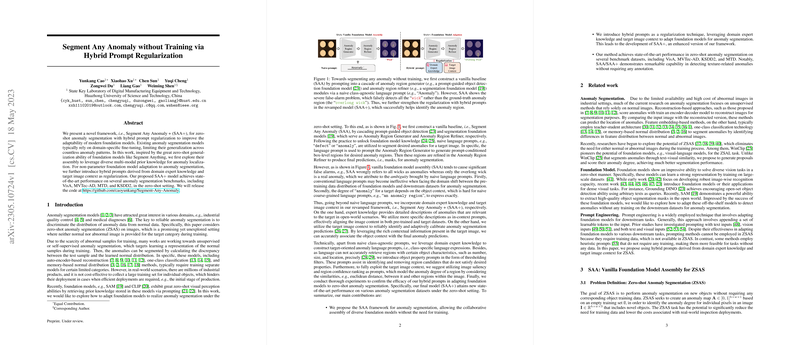Insights into "Segment Any Anomaly without Training via Hybrid Prompt Regularization"
The paper "Segment Any Anomaly without Training via Hybrid Prompt Regularization" presents an innovative approach to anomaly segmentation that capitalizes on the capabilities of foundation models for zero-shot scenarios. The authors introduce a novel framework, Segment Any Anomaly + (SAA), which leverages the adaptability of large-scale models without the need for domain-specific fine-tuning. This development represents a significant extension in the capabilities of anomaly detection, pertinent across various domains, including industrial quality control and medical diagnostics.
Framework Overview
The core contribution of the paper is the introduction of SAA, which contrasts with traditional models that require extensive training data. Instead, SAA employs a hybrid prompt regularization mechanism to enhance the performance of foundation models like SAM and CLIP in anomaly segmentation tasks. The approach embraces the zero-shot setting, where models are expected to perform on new data without prior exposure during training.
Key Components
- Zero-Shot Anomaly Segmentation (ZSAS): The paper tackles the challenging scenario of segmenting anomalies without training on specific categories, relying instead on foundation models' innate capabilities.
- Vanilla Foundation Model Assembly (SAA): The authors initially propose assembling foundation models, such as GroundingDINO for object detection and SAM for segmentation, to create a baseline that identifies anomaly regions using simple language prompts.
- Hybrid Prompt Regularization: The authors introduce a sophisticated mechanism by leveraging both domain expert knowledge and target image context:
- Language Prompts: These are refined using domain-specific and general terms to improve model guidance.
- Property Prompts: Characteristics like location and size are used to filter regions and limit false positives.
- Image Context Prompts: Saliency and anomaly confidence are used to further enhance segmentation accuracy.
Experimental Results
The empirical evaluation shows that SAA attains state-of-the-art performance across various benchmarks like VisA, MVTec-AD, KSDD2, and MTD. Notably, SAA exhibits superior ability in detecting texture anomalies, a domain consistently challenging for zero-shot models, thanks to its hybrid prompts. The results emphasize the model's robustness, achieving notable improvements in both pixel and region-level F1-scores.
Implications and Future Directions
The paper posits that the development of SAA could streamline anomaly detection deployment in industries where annotation and training data collection are impractical. The ability to harness foundation models without additional training extends the applicability of such models beyond current limitations. Looking forward, this framework could inspire extensions into other domains requiring anomaly detection and might lead to further refinements in prompt engineering to improve transfer learning capabilities.
Conclusion
This research extends the frontier of zero-shot learning by effectively adapting foundation models through innovative prompt engineering. By harnessing domain knowledge and contextual image data, SAA serves as a robust tool for anomaly segmentation without the previously requisite training. This advancement holds promise for real-world applications, reducing deployment time and resource needs across various sectors. Researchers in AI and machine learning can view this work as a significant step in the development of adaptable, self-sufficient AI systems capable of operating with minimal supervision.
